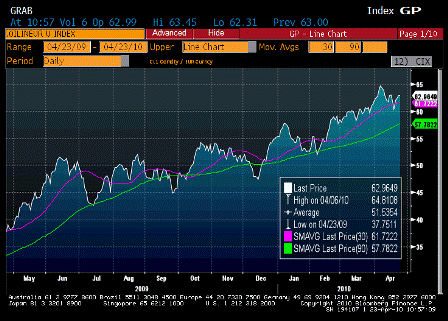By Roger Altman
April 21 (FT) — The global financial system is again transfixed by sovereign debt risks. This evokes bad memories of defaults and near-defaults among emerging nations such as Argentina, Russia and Mexico.
Yes, all fixed FX blowups.
But the real issue is not whether Greece or another small country might fail. Instead, it is whether the credit standing and currency stability of the world’s biggest borrower, the US, will be jeopardised by its disastrous outlook on deficits and debt.
This comp completely misses the fundamental difference between the two. The Fed is an arm of the US govt, while the ECB is not an arm of greece.
America’s fiscal picture is even worse than it looks. The non-partisan Congressional Budget Office just projected that over 10 years, cumulative deficits will reach $9,700bn and federal debt 90 per cent of gross domestic product – nearly equal to Italy’s.
Another apples/oranges comp. This is less than poor analysis.
Global capital markets are unlikely to accept that credit erosion. If they revolt, as in 1979,
There was no ‘revolt’ in regards to the US in 1979.
ugly changes in fiscal and monetary policy will be imposed on Washington. More than Afghanistan or unemployment, this is President Barack Obama’s greatest vulnerability.
His greatest vulnerability is listening to this nonsense, and not recognizing that taxes function to regulate aggregate demand, and not to raise revenue.
The unemployment rate is all the evidence needed, screaming there is a severe shortage of aggregate demand, and a payroll tax holiday would restore private sector sales by which employment immediately returns.
Instead, the admin is listening to this nonsense and working to take measures to tighten fiscal policy which will work to reduce aggregate demand.
How bad is the outlook? The size of the federal debt will increase by nearly 250 per cent over 10 years, from $7,500bn to $20,000bn. Other than during the second world war, such a rise in indebtedness has not occurred since recordkeeping began in 1792.
Point? Govt deficit spending adds back the demand lost because of ‘non govt’ savings desires for dollar financial assets.
The cumulative govt ‘debt’ equals and is the net financial equity- monetary savings- of the rest of us.
You could change the name on the deficit clock in nyc to the savings clock and use the same numbers.
It is so rapid that, by 2020, the Treasury may borrow about $5,000bn per year to refinance maturing debt and raise new money; annual interest payments on those borrowings will exceed all domestic discretionary spending and rival the defence budget. Unfortunately, the healthcare bill has little positive budget impact in this period.
That just means our net savings is rising and the interest payments are helping our savings rise.
In fact, treasury securities are nothing more than dollar savings accounts at the fed. Savers include us residents and non residents like the foreign countries that save in dollars.
Why is this outlook dangerous?
Because it leads to backwards policies by people who don’t get it.
Because dollar interest rates would be so high as to choke private investment and global growth.
There is no such thing.
First, rates are set by the fed.
Second, there is no imperative for the tsy to issue longer term securities or any securities at all.
Third, there is no econometric evidence high interest rates do that. In fact, because the nation is a net saver of the trillions called the national debt, higher rates increase interest income faster than the higher loan rates reduce it (bernanke, sacks, reinhart, 2004 fed paper).
It is Mr Obama’s misfortune to preside over this.
It’s his misfortune to be surrounded by people who don’t understand monetary operations. Otherwise we’d have been at full employment long ago.
The severe 2009-10 fiscal decline reflects a continuation of the Bush deficits and the lower revenue and countercyclical spending triggered by the recession. His own initiatives are responsible for only 15 per cent of the deterioration. Nonetheless, it is the Obama crisis now.
It’s the obama crisis because taxes remain far too high for the current level of govt spending and saving desires.
Now, the economy is too weak to withstand the contractionary impact of deficit reduction. Even the deficit hawks agree on that.
It’s too weak because the deficit is too small. And yes, making it smaller makes things worse.
In addition, Mr Obama has appointed a budget commission with a December deadline. Expectations for it are low and no moves can be made before 2011.
Yes, and then to cut social security and medicare!!!!
Yet, everyone already knows the big elements of a solution. The deficit/GDP ratio must be reduced by at least 2 per cent, or about $300bn in annual spending. It must include spending cuts, such as to entitlements,
Here you go!!!!!!!!!!!!!!
and new revenue. The revenues must come from higher taxes on income, capital gains and dividends or a new tax, such as a progressive value added tax.
Yes, all working to cut aggregate demand and weaken the economy.
It will be political and financial factors that determine which of three budget paths America now follows.
Yes, the backwards understanding by our leaders.
The first is the ideal. Next year, leaders adopt the necessary spending and tax changes, together with budget rules to enforce them, to reach, for example, a truly balanced budget by 2020. President Bill Clinton achieved a comparable legislative outcome in his first term. But America is more polarised today, especially over taxes.
Clinton was ‘saved’ by the unprecedented increase in private sector debt chasing impossible balance sheets of the dot com boom, which was expanding at 7% of GDP, driving the expansion even as fiscal was allowed to go into a 2% surplus, which drained that much financial equity, and ending in a crash when incomes weren’t able to keep up.
The second possible course is the opposite: government paralysis and 10 years of fiscal erosion. Debt reaches 90 per cent of GDP. Interest rates go much higher, but the world’s capital markets finance these needs without serious instability.
Japan is well over 200% (counting inter govt holdings) with the 10 year JGB at 1.35%. Interest rates are primarily a function of expectations of future fed rate settings, along with a few technicals.
History suggests a third outcome is the likely one: one imposed by global markets.
There is no history that suggests that, just misreadings of history.
Yes, there may be calm in currency and credit markets over the next year or two. But the chances that they would accept such a long-term fiscal slide are low. Here, the 1979 dollar crash is instructive.
A dollar crash, whatever that means, is a different matter from the funding issues he previously implied.
The Iranian oil embargo, stagflation and a weakening dollar were roiling markets. Amid this nervousness, President Jimmy Carter submitted his budget, incorporating a larger than expected deficit. This triggered a further, panicky fall in the dollar that destabilised markets. This forced Mr Carter to resubmit a tighter budget and the Fed to raise interest rates. Both actions harmed the economy and severely injured his presidency.
The problem was the policy response to the ‘dollar crash.’ rates went up because the fed raised them with a vote. Market forces aren’t a factor in the level of rates per se. They are part of the Fed’s reaction function, which is an entirely different matter.
America’s addiction to debt poses a similar threat now. To avoid an imposed and ugly solution, Mr Obama will have to invest all his political capital in a budget agreement next year. He will be advised that cutting spending and raising taxes is too risky for his 2012 re-election. But the alternative could be much worse.
So it’s all about avoiding a dollar crash?
So why are we pressing china to revalue their currency upward which means reducing the value of the dollar? Can’t have it both ways?
Altman was in the Clinton admin confirms they were in the ‘better lucky than good’ category.
Feel free to distribute, thanks.



